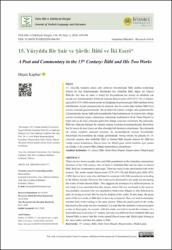15. Yüzyılda Bir Şair ve Şârih: İlâhî ve İki Eseri
Abstract
15. yüzyılda Anadolu sahası şerh edebiyatı literatüründe İlâhî mahlası kullandığı bilinen iki kişi bulunmaktadır. Bunlardan biri Abdullah İlâhî, diğeri ise Ahmed İlâhî’dir. Her ikisi de şârih ve Nakşî’dir. Kaynaklarda her ikisine de atfedilen çok sayıda eser bulunmaktadır. Elimizde bulunan Rûşenî-nâme (878/1473-74) ve Müşkilgüşâ (884/1479-1480) isimli eserler de kütüphane kayıtlarına göre İlâhî mahlaslı birine atfedilmiştir. Ancak çalışmamızda ele alınacak olan bu eserler diğer bilinen İlâhî’lerin eserleri arasında geçmemektedir. Bu da farklı bir kişinin varlığını akla getirmektedir. Çalışmamızda, hayatı hakkında kaynaklarda bilgi bulunmayan bu kişinin kim olduğu eserleri üzerinden ortaya çıkarılmaya çalışılarak muhtemelen Dede Ömer Rûşenî’ye bağlı olan ya da onun yolundan giden biri olduğu sonucuna varılmıştır. Bu çalışmada, İlâhî’nin elimizde bulunan iki eserinin mensur kısımları karşılaştırılmıştır. Böylelikle her iki eserin de aynı kişiye ait olup olmadığı belirlenmeye çalışılmıştır. Bu çalışmada ele alınan eserlerin manzum kısımları da incelendiğinde mensur kısımlardaki benzerliğin bu kısımlarda da olduğu görülmüştür. Sonuç olarak; bu çalışma ile 15. yüzyılda yaşamış olan Abdullah İlâhî ve Ahmed İlâhî dışında üçüncü bir İlâhî’nin varlığı ortaya konulmaya, Rûşenî-nâme ile Müşkil-güşâ isimli eserlerin aynı yazara ait olduğu ve bu yazarın İlâhî olduğu ispatlanmaya çalışılmıştır There are two known people who used Ilâhî pseudonym in the Anatolian commentary literature of the 15th century. One of them is Abdullah Ilâhî and the other is Ahmed Ilâhî. Both are commentaries and naqxi. There are many works attributed to both in the sources. The works named Rûşenî-nâme (878/1473-74) and Müşkil-güşâ (884/1479-1480) that we have were also attributed to someone with Ilâhî pseudonym according to the library records. However, the works to be discussed in our study are not among the works of other known Ilâhî's. This suggests the existence of a different person. In our study, it was concluded that this person, whose life was not found in the sources, was probably someone who was attached to Dede Omer Rûşenî or who followed his path, by trying to reveal who he was by looking at his works. In this study, the prose parts of the two works of Ilâhî that we have are compared. Thus, we tried to determine whether both works belong to the same person. When the poetic parts of the works discussed in this study are also examined, it is seen that the similarity in the prose parts is also in these parts. As a result, with this study, we tried to reveal the existence of a third Ilâhî who lived in the 15 th century and who was different from Abdullah Ilâhî and Ahmed Ilâhî, to prove that the works named Rûşenî-name and Müşkil-güşâ belong to the same author and that this author is Ilâhî.
Source
İstanbul Üniversitesi Edebiyat Fakültesi Türk Dili ve Edebiyatı DergisiVolume
60Issue
2URI
https://doi.org/10.26650/TUDED2020-806384https://app.trdizin.gov.tr/makale/TkRFek9EWTFOUT09
https://hdl.handle.net/20.500.11857/1823
Collections
- Makale Koleksiyonu [624]
- TR-Dizin İndeksli Yayınlar Koleksiyonu [1037]



















